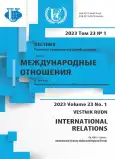The Logic of International Response to Anti-Violence and Sexual Integrity Agenda in Violent Conflict: Case of MINUSCA
- Authors: Bokeriya S.A.1, Andronova A.R.1
-
Affiliations:
- Peoples’ Friendship University of Russia (RUDN University)
- Issue: Vol 23, No 1 (2023): International Security: Global and Regional Trends
- Pages: 20-36
- Section: THEMATIC DOSSIER
- URL: https://journal-vniispk.ru/2313-0660/article/view/320492
- DOI: https://doi.org/10.22363/2313-0660-2023-23-1-20-36
- EDN: https://elibrary.ru/UYWWUY
- ID: 320492
Cite item
Abstract
A survivor-centered approach is at the heart of the international community’s humanitarian action today. In armed conflicts various forms of sexual violence are seen not only as accompanying violence, but also as a tool of pressure and warfare of the contesting parties, and important measures to prevent and counteract such acts have been included into the mandates of the UN peacekeeping missions. This research aims to identify the logic of international community’s action to counter conflict-related sexual violence (CRSV) by strengthening peacekeeping initiatives, and complement ongoing research on the protection of women in armed conflict and situations of sexual violence. This goal entails an examination of all elements of the existing system: legal framework, the role of states, and the activities of the UN. The authors conducted a content analysis of the UN Security Council resolutions on the topic to trace conceptual terminological changes. At the same time, to identify the main contradictions in the rhetoric of states and, consequently, the motives of their actions, a discourse cluster analysis was used based on the statements of delegations in the UN Security Council. The resulting clusters display three unique positions of the national states that are mostly explained by different understandings of the term itself, the categories of victims of such violence, and the relevant tools for countering it. Emphasis could be placed on including sexual violence on the sanctions list, gender education in military training, increasing the number of women in peacekeeping and peacebuilding missions, or preventive measures. The authors identified the most active states pushing the anti-sexual violence agenda; they include Germany, the UK, the US, Canada, and France. The article also examines the practical implementation of UN peacekeeping mandates in terms of including measures to counteract sexual violence. The research confirms that peacekeeping missions are now more actively engaged in the international response to CRSV.
About the authors
Svetlana A. Bokeriya
Peoples’ Friendship University of Russia (RUDN University)
Author for correspondence.
Email: bokeria-sa@rudn.ru
ORCID iD: 0000-0002-9052-4363
PhD (Law), Associate Professor, Department of Theory and History of International Relations
Moscow, Russian FederationAnastasiia R. Andronova
Peoples’ Friendship University of Russia (RUDN University)
Email: andronova-ar@rudn.ru
ORCID iD: 0000-0001-6598-0941
Postgraduate Student, Department of Theory and History of International Relations
Moscow, Russian FederationReferences
- Agerberg, M., & Kreft, A.-K. (2020). Gendered conflict, gendered outcomes: The politicization of sexual violence and quota adoption. Journal of Conflict Resolution, 64(2-3), 290-317. https://doi.org/10.1177/0022002719859651
- Bove, V., & Ruggeri, A. (2016). Kinds of blue: Diversity in UN peacekeeping missions and civilian protection. British Journal of Political Science, 46(3), 681-700. https://doi.org/10.1017/S0007123415000034
- Brouwer, A., & Ruiz, L. (2019). Male victims and female perpetrators of sexual violence in conflict. In S. Mouthaan & O. Jurasz (Eds.), Gender and war: International and transitional justice perspectives (pp. 169-208). Cambridge: Intersentia. https://doi.org/10.1017/9781780688466.008
- Buss, D. (2017). Seeing sexual violence in conflict and post-conflict societies: The limits of visibility. In D. Buss, J. Lebert, B. Rutherford, et al. (Eds.), Sexual violence in conflict and post-conflict societies (pp. 3-28). New York: Routledge. https://doi.org/10.4324/9781315772950
- Cohen, D. K. (2013). Explaining rape during civil war: Cross-national evidence (1980-2009). American Political Science Review, 107(3), 461-477. https://doi.org/10.1017/S0003055413000221
- Copelon, R. (2011). Toward accountability for violence against women in war: Progress and challenges. In E. D. Heineman (Ed.), Sexual violence in conflict zones: From the ancient world to the era of human rights (pp. 232-256). Philadelphia: University of Pennsylvania Press. https://doi.org/10.9783/9780812204346.232
- Eboe-Osuji, C. (2012). International law and sexual violence in armed conflicts. Leiden: Brill. https://doi.org/10.1163/9789004227224
- Green, A. H. (2016). The commander’s dilemma: Creating and controlling armed group violence. Journal of Peace Research, 53(5), 619-632. https://doi.org/10.1177/0022343316653645
- Gutiérrez-Sanín, F., & Wood, E. J. (2017). What should we mean by “pattern of political violence”? Repertoire, targeting, frequency, and technique. Perspectives on Politics, 15(1), 20-41. https://doi.org/10.1017/S1537592716004114
- Hartigan, J. A., & Wong, M. A. (1979). Algorithm AS 136: A K-means clustering algorithm. Journal of the Royal Statistical Society. Series C (Applied Statistics), 28(1), 100-108. https://doi.org/10.2307/2346830
- Hultman, L., & Johansson, K. (2017). Responding to wartime sexual violence: UN peacekeeping and the protection agenda. Global Responsibility to Protect, 9(2), 129-146. https://doi.org/10.1163/1875984X-00902002
- Hultman, L., Kathman, J., & Shannon, M. (2013). United Nations peacekeeping and civilian protection in civil war. American Journal of Political Science, 57(4), 875-891 https://doi.org/10.1111/ajps.12036
- Johansson, K., & Hultman, L. (2019). UN peacekeeping and protection from sexual violence. Journal of Conflict Resolution, 63(7), 1656-1681. https://doi.org/10.1177/0022002718785003
- Karim, S., & Beardsley, K. (2015). Ladies last: Peacekeeping and gendered protection. In L. Olsson & T.-I. Gizelis (Eds.), Gender, peace and security: Implementing UN Security Council Resolution 1325 (pp. 62-95). London: Routledge. https://doi.org/10.4324/9781315755694
- Kathman, J. D., & Wood, R. M. (2016). Stopping the killing during the “peace”: Peacekeeping and the severity of postconflict civilian victimization. Foreign Policy Analysis, 12(2), 149-169. https://doi.org/10.1111/fpa.12041
- Kreft, A.-K. (2016). The gender mainstreaming gap: Security Council resolution 1325 and UN peacekeeping mandates. International Peacekeeping, 24(1), 132-158. https://doi.org/10.1080/13533312.2016.1195267
- Kreft, A.-K. (2019). Responding to sexual violence: Women’s mobilization in war. Journal of Peace Research, 56(2), 220-233. https://doi.org/10.1177/0022343318800361
- Wood, E. J. (2008). Sexual violence during war: Toward an understanding of variation. In S. Kalyvas, I. Shapiro & T. Masoud (Eds.), Order, conflict, and violence (pp. 321-351). Cambridge: Cambridge University Press. https://doi.org/10.1017/CBO9780511755903.014
- Wood, E. J. (2014). Conflict-related sexual violence and the policy implications of recent research. International Review of the Red Cross, 96(894), 457-478. https://doi.org/10.1017/S1816383115000077
Supplementary files









